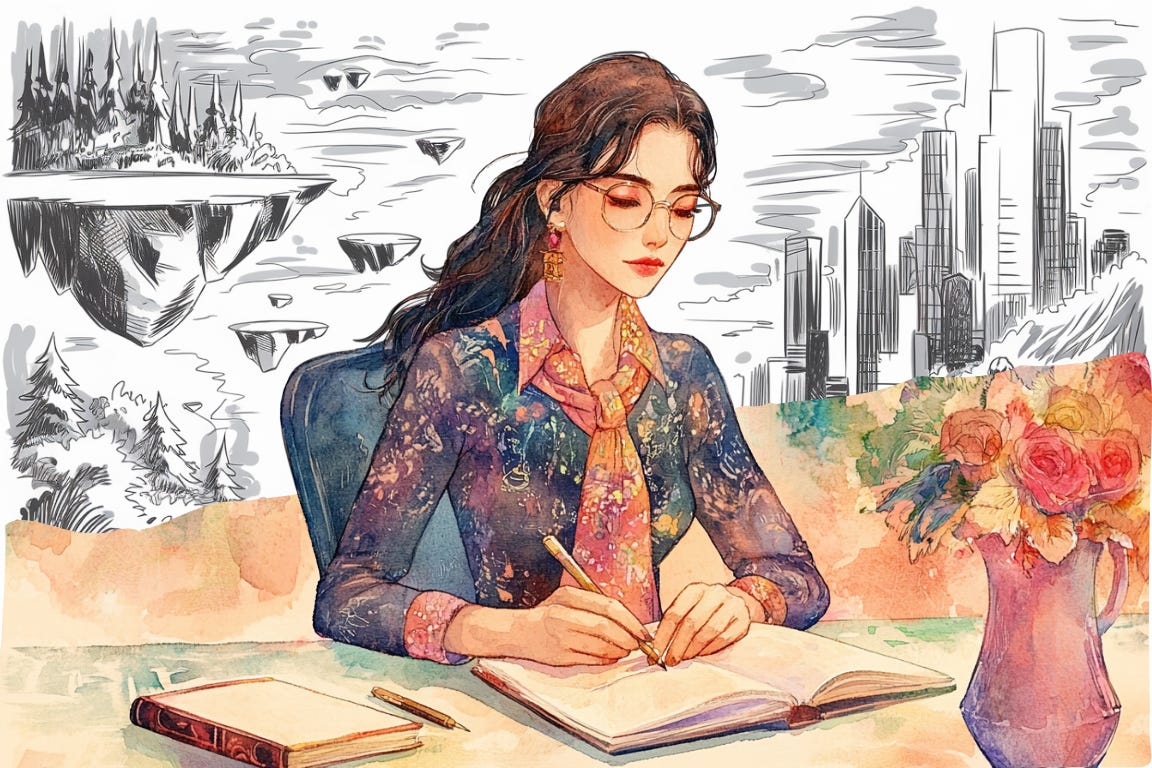⋙ Master the Fundamentals, Keep the Streak Alive ⋘
Bookmark these daily “streak savers” from Writing Streak.
The most unoriginal question you can ask a writer is, "Where do you get your ideas?" This is a bit like asking a cook where their hamburger was raised. Neither the cook nor the writer know. But I think there's a reason why this question is so ubiquitous at author Q&A's, and it's related to the second most asked question famous writers hear.
"How do you deal with writer's block?"
The idea that you need an idea often leads to writer's block. The would-be writer believes in a computational model of writing where stories are generated by either summaries or mental models which the writer can then describe with their words. But words generate ideas, not the other way around. With words you generate scenarios constructed from settings, characters, and tasks to be performed. This in turn is how you discover what is possible.
Are you waiting for ideas? Or worse, do you have a beautiful idea impossible to convey through words? This week, let's drop those ideas and practice writing without an idea in our heads. You can always trudge back to the idea pit if this doesn't work out.
By the way, if you want to get a writer talking, I have an idea. Ask them why they haven't finished their next book, yet.
This Week’s Streak Savers 🪦
⋙ Monday, Nov 11: Waiting Room Rumba
Setup: A character is stuck waiting, and their boredom leads them to notice and interact with the objects around them.
Goal: Endear the character to the reader. Reveal personality through the character’s idle interactions with their environment.
Constraints:
Start by describing the character's physical position
Show their thoughts only through their physical interactions
Write until you discover something surprising about the character
Modification: For added challenge, have the character interact with an unknown object.
Reflection: Did your character's way of interacting with objects reveal things about them that you hadn't planned?
⋙ Tuesday, Nov 12: Object-to-Story
Setup: Place a distinctive object in a public space and show several different characters interacting with it.
Goal: Create an immersive reality for the reader. Show how different characters perceive and interact with the same object differently.
Constraints:
Describe the object's placement before introducing any characters
Show at least three characters interacting with it separately and differently
Let the final interaction change the object's state or position
Modification: For more of a challenge, build a larger narrative with the characters’ interactions.
Reflection: What unexpected connections emerged between the characters through their interactions with the object?
⋙ Wednesday, Nov 13: Dialogue Discovery
Setup: Two unknown characters begin speaking. One makes an ambiguous statement or asks a confusing question.
Goal: Engage readers by letting character goals and relationships emerge naturally through dialogue. Discover who these people are through their words.
Constraints:
Begin with a line of dialogue that could have multiple meanings
Add only minimal dialogue tags or action beats
End the conversation on a question
Reflection: At what point in writing the dialogue did you discover what your characters wanted?
⋙ Thursday, Nov 14: Follow the Thread
Setup: Start with either a line of description or simple action. Let each subsequent sentence follow naturally from this first sentence.
Goal: Create a sense of immediacy for the reader by discovering the scene as you write it, letting each moment suggest the next.
Constraints:
Don't pause to plan ahead
Each sentence must connect directly to something in the previous sentence
Write until the scene reaches a natural conclusion
Reflection: How did focusing on immediate connections between sentences affect the scene's pacing?
⋙ Friday, Nov 15: From Place to Place
Setup: A character moves through three distinct locations, performing an action in each. Only the final action reveals their true goal.
Goal: Maintain reader engagement through intrigue. letting the meaning of the journey emerge through writing rather than pre-planning.
Constraints:
Start by placing the character in the first location
Include a specific action in each setting
Connect each setting through the character's movement
Don't decide the character's goal until writing the final action
Modification: For a simpler version, use just two locations but make the connection between them more detailed.
Reflection: When did you discover the character's true purpose?
⋙ Saturday, Nov 16: Environmental Transition
Setup: Begin with a vivid detail of an environment in one state that will change gradually through the piece.
Goal: Create reader immersion through rich environmental detail, allowing the changing setting to suggest and shape a narrative arc.
Constraints:
Start with a specific sensory detail of the environment
Show at least three distinct stages of environmental change
Let the final state of the environment reveal the passage’s meaning
Modification: For a simpler version, focus on just two contrasting states of the environment, making the transition between them more detailed.
Reflection: How did the changing environment suggest story elements you hadn't planned?
⋙ Sunday, Nov 17: One-Page Viewpoint Scene
Setup: Write a scene involving an object or event, that three characters witness.
Goal: Engage readers through gradual revelation. Write the same scene from three different perspectives, letting each new viewpoint reveal unexpected aspects.
Constraints:
First perspective establishes the basic scene
Second perspective must notice different physical details
Third perspective must reveal something neither of the others saw
Each perspective should be roughly the same length
Modification: For an advanced challenge, make each perspective contradict something from the previous one, discovering how the same moment can be experienced differently.
Reflection: How did each new viewpoint change your understanding of the scene?




